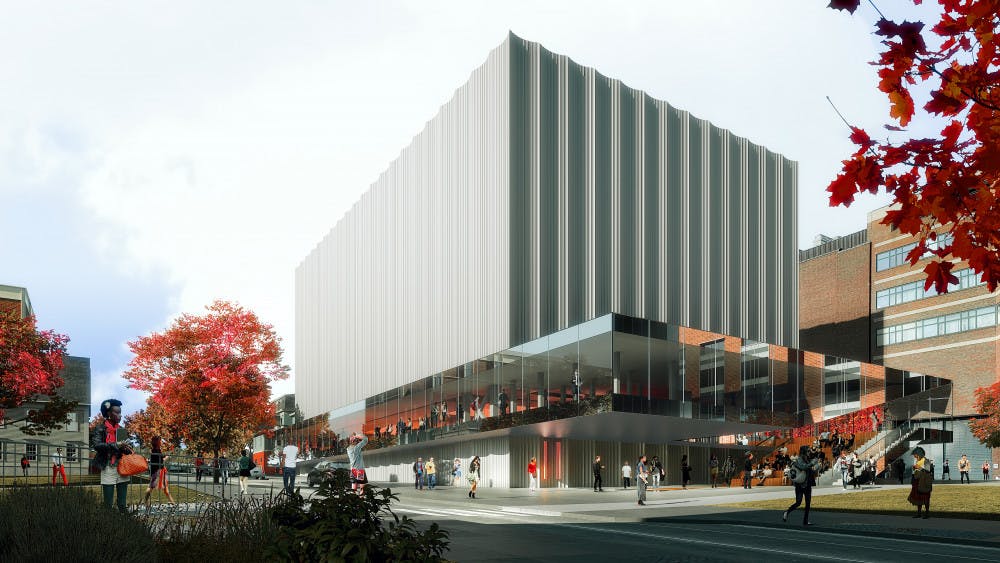Updated 8:09 P.M. Feb. 13, 2019.
The design of the planned new Performing Arts Center was announced yesterday by the University and New York-based architecture firm REX.
The PAC, set for completion in 2022, will be located between Angell and Olive streets, The Herald previously reported.
The new PAC will feature a versatile main performance hall that can be transformed into various configurations, “ranging from a 625-seat symphony orchestra hall, to a 250-seat proscenium theater, to an immersive surround sound cube for experimental media performance,” according to the press release. Reconfiguring the space for different uses could take less than a day. Aside from the main hall, the building will also house multiple smaller studios and rehearsal spaces.
The adaptability of the structure will allow for multiple types of performing arts — such as performances by the Brown University Orchestra or digital media installations — within the space. According to the press release, REX designed five presets into which the center can be transformed: Orchestra, which arranges the space like a traditional concert hall; Recital, which is a smaller space intended for soloists and small ensembles; End Stage, which is designed for theater and dance performances; Experimental Media, which “configures the space into a small cube”; and Flat Floor, which removes all seating. The space can be transformed based on acoustic need as well.
During an event hosted by the Brown Arts Initiative at the Granoff Center for the Creative Arts Wednesday morning, Joshua Ramus, founding principal of REX,showed animations illustrating the shifts between the five different presets, displaying how the walls, seats and floor can be shifted to create distinct configurations. At its greatest capacity, the Flat Floor preset can fit 850 people, Ramus said.
The need for a space large enough to accommodate the University’s 100-piece orchestra and 80-singer chorus inspired the size of the main hall, Ramus said in the press release. The orchestra has been requesting a larger space for 50 years, Ramus added during his talk.
The center will display a 13-foot “horizontal ‘clearstory’ that slices through the building’s facade at stage level” and overlooks The Walk, which connects main campus to the Pembroke campus, according to the release. This transparent clearstory will allow passersby to view “performances, rehearsals and arts scholarship” from the outside in an effort to bridge the gap between the greater Providence community and students engaged in arts at the University.
REX paid special attention to the acoustics of the clearstory, making sure that noise from outdoors would not negatively affect the sound inside the structure.
On the exterior, “the building will be shrink-wrapped in an extruded aluminum rainscreen,” Ramus said in the release.
Ramus hopes that the new PAC will “redefine (The Walk) as a hub for the arts.” He also noted that the task of combining the needs of a large orchestra with those of smaller, more intimate performances was ambitious and unprecedented. But “this is something to celebrate, not something to fear,” he said.
The structure’s design allows the public to peek into the rehearsal process, which in turn could increase patronage for actual performances, Ramus said during his talk.
Outside the building, there will be an outdoor plaza at the base of the entrance, which will serve as a gathering space for students, performers and visitors. The building will also house various multi-use spaces, including a percussion studio and dressing rooms, below street level.
Butch Rovan, professor of music and faculty director of BAI, expressed enthusiasm for the new PAC in an interview with The Herald. “It will finally bring to Brown the world-class performance facilities that it has never had and the kinds of resources that we should be providing to match our incredible students’ talents,” Rovan said. “It will enable collaborations that we cannot do right now — we do not have many spaces that are amenable to large-scale collaborations between music, dance and theater.”
Ramus and the University hope that the building will be used by professionals from disciplines beyond the arts as well. “The PAC will vastly expand Brown’s ability to create and stage new and existing works, combine art forms and welcome world-renowned faculty and artists to learn from and inspire scholars across disparate fields of study,” according to the press release.
REX designed the building with input from BAI, members of the Providence community and University students, according to the press release and Ramus. The firm sought to ensure that the space could be used not only by students and faculty, but also by local residents.
Ramus also touched on the change in the proposed location for the new PAC. The original proposal would have demolished four buildings and situated the new PAC between Angell and Waterman streets, The Herald previously reported. To address concerns about the original plot, the project was moved to a location between Angell and Olive streets and a portion of the building was moved underground. Though there were cost implications associated with the switch, Ramus said, it was “the absolute best thing for the project.”
Due to the flexibility of the new PAC, the opportunities for creation and experimentation are boundless, Rovan said. “The space will allow us to create kinds of collaborative art-making that don’t even exist yet,” he said. “The building itself is like a creative partner, in a way that no other building will be. It will really be one-of-a-kind in the country.”
An earlier version of this article stated that reconfiguring the main performance hall for different uses will take one to two weeks. In fact, it is possible to reconfigure the space in less than one day. Due to an editing error, an earlier version of this article omitted the titles and full names of Joshua Ramus, founding principal of REX, and Butch Rovan, professor of music and faculty director of the Brown Arts Initiative. The Herald regrets the errors.





